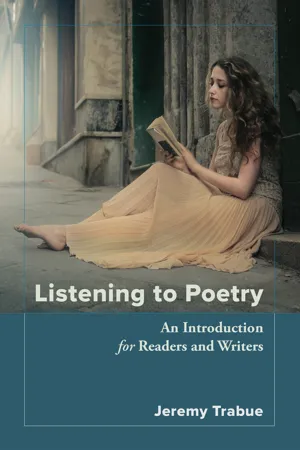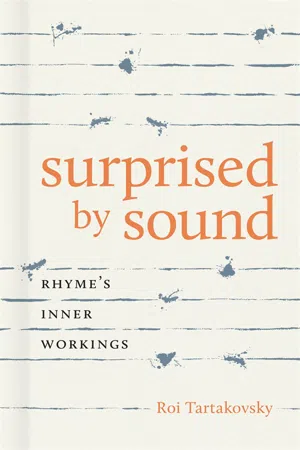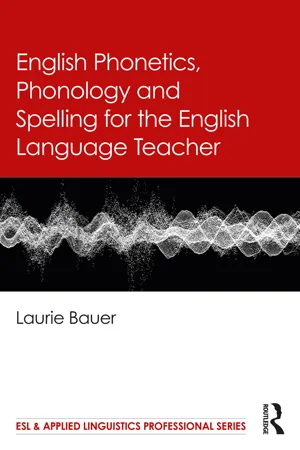Languages & Linguistics
Monosyllabic Rhyme
A monosyllabic rhyme occurs when the last syllable of two or more words rhyme and each word contains only one syllable. This type of rhyme is commonly found in poetry and song lyrics and can create a simple and impactful rhythmic effect. Examples of monosyllabic rhymes include words like "cat" and "bat" or "dog" and "log."
Written by Perlego with AI-assistance
Related key terms
6 Key excerpts on "Monosyllabic Rhyme"
- eBook - ePub
Listening to Poetry
An Introduction for Readers and Writers
- Jeremy Trabue(Author)
- 2019(Publication Date)
- Chemeketa Press(Publisher)
Rhyme schemes are also commonly used prescriptively, too, as part of describing a received form. For example, the Shakespearian sonnet is partially defined by conforming to the rhyme scheme ABAB / CDCD / EFEF / GG.Final Thoughts
Many poems tell interesting stories, but all poems are at least a little bit like a song. The musicality of language itself is the heart and soul of many poems. Hearing that music is central to understanding and appreciating them. The variety of sounds that words make can create a subtle music all by itself.The syllable is a basic unit of language, generally defined as the sound of a vowel and the consonants around it. In English, syllables can be accented or unaccented, and this basic feature of the language is something that poems can fashion into musical patterns. Rhyme, most broadly, is the repetition of ending sounds in words, usually at the ends of lines. Rhyme is fundamentally simple but also exists in many variations and can be created, manipulated, and mixed with other song elements in many ways.To finish off the chapter, here’s a list of reminders, tips, and tricks to help you as you work with musical language:• In dealing with any song element, read out loud, read out loud, read out loud. Then have someone read to you and listen with the poem in front of you and a pencil in your hand. There is no substitute for feeling the poem in your mouth and hearing it in another voice. Get help from a real human being, in person, if you can. This isn’t the easiest material to learn from the silent page.• Scribble all over the poems. It’s hard to keep track of all the individual pieces in your head while you try to figure out what kind of pattern they make. Making notes as you find the sounds allows the pattern to emerge naturally.• When analyzing syllables, use the dictionary to locate the syllable breaks and the stress patterns in multisyllabic words.• When listening for rhyme specifically, try reading, at least at first, only the last syllable of each line out loud. “Close enough” gen erally counts in rhyme. If you can reasonably imagine a word rhyming, let it rhyme. - eBook - ePub
Surprised by Sound
Rhyme's Inner Workings
- Roi Tartakovsky(Author)
- 2021(Publication Date)
- LSU Press(Publisher)
1 Hearing and Listening to Rhyme If negotiating with linguistic constraints and literary conventions comes with the territory of writing poetry, rhyme occupies a great part of that territory. Certainly, in the case of English, it is difficult to overstate the association between rhyme and poetry, or the significance of rhyme to poetry. This association is attested to in rhetoric by rhyme’s synecdochic or metonymic substitution for poetry itself. Rhyme-as-poem is a prevalent trope throughout much English-language poetry and is nowhere more evident than in William Shakespeare’s ending of Sonnet 17: “You should live twice, in it and in my rhyme.” In practice, rhyme’s prevalence is attested to by the overwhelming number of rhymed poems written by generations of poets. Of course, rhyme is not the only sound device, nor the earliest in the history of English poetry. A perfect or full rhyme is, in fact, one of numerous poetic sound devices, including assonance, alliteration, consonance, and many forms of partial rhymes. But it is the more encompassing member among most of these weaker or partial sound relations because full rhyme typically requires a correspondence of both the vowel and the following consonant sounds of the last stressed syllable of each word. 1 Assonance was never used systematically in English verse, partial rhyme is best appreciated as a subset of full rhyme, and alliteration, while carrying its own historical connotations of Anglo-Saxon prosody, seems, at least in poetic consciousness, more distant and dimmed today than rhyme. 2 Rhyme, both historically and phonetically, is set up to stand out in the soundscape of the poem or of poetry. As prevalent as rhyme is (or was —a question I will get to momentarily), it is easy to forget that rhyme’s entry into English poetry was a gradual process and one that—in spite of scholarly interest—remains somewhat murky. Murkier yet is the larger question of the historical origin of rhyme itself - eBook - ePub
The Princeton Encyclopedia of Poetry and Poetics
Fourth Edition
- Stephen Cushman, Clare Cavanagh, Jahan Ramazani, Paul Rouzer, Stephen Cushman, Clare Cavanagh, Jahan Ramazani, Paul Rouzer, Stephen Cushman, Clare Cavanagh, Jahan Ramazani, Paul Rouzer(Authors)
- 2012(Publication Date)
- Princeton University Press(Publisher)
cywydd couplets, one of the rhymes must be a monosyllable but the other a polysyllable. But if rhyme depends for its distinctive effects on the morphology of the particular words involved in the rhyme, it also, therefore, depends on the morphological structure of the lang. itself as the ground against which the pattern becomes visible.Inflectional endings are, as it were, the antithesis or reflex of rhyme, though it is not accurate to say, as did Whitehall, that langs. in which like endings result automatically from inflection will never use rhyme as a structural device in verse. Rhyme is occasionally to be found, consciously used, in the lit. of the cl. langs. The notion of like endings (Gr. homoeoteleuton , Lat. similiter desinens ) is discussed by the ancients—Aristotle (Rhetoric 3.9.9–11), Dionysius of Halicarnassus (23), and Quintilian (9.3.77)—under the rubric of “verbal resemblance” or sound correspondence between clauses (paromoeosis ). Late antique *rhyme-prose continues this trad.; the *grammatical rhyme of the Grands Rhétoriqu eurs (see RHÉTORIQUEURS, GRANDS ) takes a different slant. But the two systems—case endings and rhyme—overwrite the same space and so in the main are mutually exclusive. And when, in any lang., rhyming is relatively easy, poets will tend to complicate it by employing forms of *rich or *identical rhyme (as in Fr.) or complex stanza forms (as in Occitan and Fr.) or both, or else by eschewing rhyme completely (as in *blank verse). Poets who choose to rhyme, in fact, walk a tightrope between ease and difficulty: too easy rhyming or too difficult rhyming eventually produce the same result—the poetic disuse of rhyme. In some verse systems, the rules in a prosody survive sometimes for centuries after the ling. facts on which they were originally based have disappeared. One of the chief instances of this process is the mute e - eBook - ePub
Reclaiming the Christian Intellectual Tradition
A Student's Guide
- Louis Markos, David S. Dockery, David S. Dockery(Authors)
- 2012(Publication Date)
- Crossway(Publisher)
Don Juan , the light operas of Gilbert and Sullivan, and comedy-driven Broadway musicals all make heavy use of feminine rhymes.) By truncating his trochaic lines, the poet ensures that his lines will end on a stress—thus allowing him to use masculine rhymes. Consider the difference in feel and gravity between the following two pairs of lines (truncated trochaic tetrameter, followed by trochaic tetrameter):Nothing in my hand I bring, / Simply to the cross I cling Nothing in my hand I’m bringing / Simply to the cross I’m clingingThere is a firmness and nobility in the first pair of lines that is compromised in the second by the use of the less stately feminine rhyme, “bringing/clinging.”CATEGORIZING STANZAS
Thus far, I have considered individual lines of poetry in isolation. When we read actual poems, we encounter them not as individual lines but as members of a tightly knit group of lines known as a stanza . These stanzas are defined both by the meter of the lines that make them up and by the rhyme scheme that binds the lines together. Though it is possible to make use of a stanza that does not rhyme, in nearly all cases, the stanza will contain at least one pair of rhyming words. To designate the rhyme scheme of a stanza, we use the letters of the alphabet. If the four lines of a four-line stanza end with the words “may/sea/day/me,” then the rhyme scheme would be written thus: abab . If the last four words were “may/day/sea/me,” then the rhyme scheme would be aabb . If the last four words were “may/see/you/me,” then the rhyme scheme would be abcb . Although the majority of rhymes are exact rhymes (feel/steal), poets often use rhymes that are not exact (known as off rhymes or eye rhymes - eBook - ePub
Linguistica
Selected Papers in English, French and German
- Otto Jespersen(Author)
- 2015(Publication Date)
- Routledge(Publisher)
It is easy enough in English to build up whole sentences consisting exclusively or chiefly of monosyllables, e.g. Last week John gave his young wife a smart, small, cheap, straw hat'; we have many monosyllabic proverbs and similar sayings, like First come, first served', 'Haste makes waste, and waste makes want', Live and learn'; cp. also the Biblical "In the sweat of thy face shalt thou eat bread" and "Thou shalt not steal'. From poets we may quote Love no man; trust no man: speak ill of no man to his face; nor well of any man behind his face' (B. Jonson), 'And ten dull words oft creep in one dull line' (Pope), 'Then none were for the party; Then all were for the state; Then the great man help'd the poor, and the poor man loved the great' (Macaulay), 'The long day wanes: the slow moon climbs: the deep Moans round with many voices' (Tennyson), and so on down to the hymn of the I.W.W. (International Workers of the World): 'Work and pray, Live on hay; You'll get pie When you die.'Monosyllables constitute the most indispensable part of the English vocabulary and are with few exceptions those words which the small child learns first. It has proved possible to bring out children's books containing not a single word with more than one syllable, and in Professor Edward L. Thorndike's careful calculation of the words which are found to occur most widely in English, the list containing the 500 most frequently used words comprises 400 monosyllables, and only 100 words of two or three syllables.1What are the causes that have led to this predominant monosyllabism in English? In the first place we must here mention the tendency found in all languages, but stronger in English than in most other languages, to pronounce non-stressed vowels indistinctly and finally to leave them out altogether, if superfluous for the understanding. Through this, especially through the mutescence in the fourteenth century of a very great number of weak e' s (corresponding to fuller vowels in earlier periods), many words have been reduced to monosyllables. The extent may be judged from the simple fact that on one page of narrative Old English prose (the first page of Wulfstan's report to King Alfred) no less than sixty-nine words have been reduced from two or three syllables to one, while only sixteen have been preserved as polysyllables, and of these six have been reduced from three or four syllables to two.2 - Laurie Bauer(Author)
- 2023(Publication Date)
- Routledge(Publisher)
Teachers will probably want to concentrate on those parts of prosody which are most different from what is found in the students’ L1 and which might, as a result, be misleading in some way. Some clues on teaching parts of this are given in the text. Voice quality and intonation may be approached by thinking about how to sound – kind, friendly, sympathetic, cross, officious, rude and so on – and then avoiding these when they are not intended.Passage contains an image
6 Phonotactics and syllables
DOI: 10.4324/9781032637020-8Syllables are phonetic units between the segment and the word. When we scan poetry, we count syllables in English. The word word has one syllable (it is monosyllabic), and the word wordy has two (it is disyllabic). The word polysyllabic has five syllables. The syllable is a familiar unit in many languages; many use writing systems that write in syllables, for instance. In order to demarcate syllables, we need to consider phonotactics, the ways in which individual segments combine within words. Since both of these notions are based on a preliminary notion of sonority, the presentation will start there.6.1 Sonority
Sounds which, at the same volume, are easier to hear at a distance are said to be more sonorous that sounds which do not carry as well. Vowels are more sonorous than consonants, and in both cases, the more sonorous sounds are pronounced with less obstruction of the vocal tract. Although there is some discussion of the uses of sonority and the relative sonority of particular sounds in the literature, for our purposes the hierarchy of sonority in Table 6.1 will be all that we need.Table 6.1 Relative sonority of English soundsSonority < Increasing Decreasing > Obstruents Nasals Liquids ([ɹ] and [l]) Semi-vowels ([j] and [w]) Close vowels Open vowels 6.2 Phonotactics of monosyllabic words
To make things simpler, we will consider the phonotactic make-up of monosyllabic words. The assumption will be that if we know how segments can combine in single syllables, we can deduce how they will combine in multiple syllables. This works quite well in English, though it creates minor problems in some other languages.
Index pages curate the most relevant extracts from our library of academic textbooks. They’ve been created using an in-house natural language model (NLM), each adding context and meaning to key research topics.





